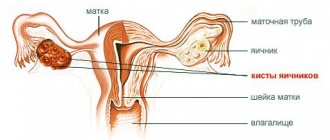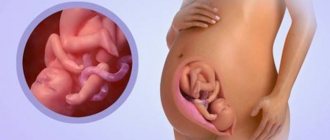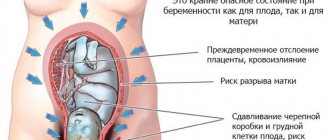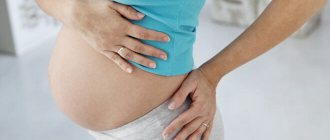At this stage of pregnancy, as a rule, the woman already knows about her interesting situation, since at the 8th week the baby is already clearly making itself known with pronounced symptoms. Knowing about her pregnancy, a woman should take great care of herself, get rid of bad habits, and do everything possible to protect her unborn baby. The period of eight weeks refers to the critical period of pregnancy; the slightest negative factors affect the development of the fetus and the health of the mother.
While at this stage, a woman should take care of comfortable underwear, especially a bra, because at this time the breasts begin to enlarge, and you can even see blood vessels on them. This action of hormones prepares the mammary glands for lactation. The skin may change; it can be either cleansed and elastic, or, conversely, dry and flaky.
Signs of pregnancy at 8 weeks
The eighth week of pregnancy is usually accompanied by pronounced symptoms. But there are times when signs of pregnancy do not show themselves, this may worry the woman, is everything okay? Basically, in the 8th week of pregnancy, all the signs appear quite clearly; this may be toxicosis, during which you often feel dizzy, nausea and vomiting.
If vomiting occurs no more than 2 times a day, this is considered normal. In order to combat this phenomenon, you should follow a certain diet. But in case of severe toxicosis, it is recommended to consult a doctor, since severe and frequent vomiting negatively affects the development of the baby.
Fetal development at 8 weeks
At this stage, the embryo can safely be called a fetus. The internal organs have already formed, but they are still in their infancy and have not taken their proper places. At the moment, the length of the baby is approximately 20 mm, the weight reaches 3 grams.
- All organs are formed and continue to grow.
- The small intestine contracts.
- This week the rudiments of female or male genital organs appear.
- The fetal body lengthens and straightens.
- Pigments appear in the fetal eyes.
- Bones and cartilage are formed.
- Muscle tissue develops.
- At this stage of development, the brain sends an impulse to the muscles, and the baby begins to react to surrounding events. If something doesn’t suit him, he winces and shudders, but you, of course, won’t feel it.
- In the eighth week of development, four faces are formed (nose, lips, chin).
- Constrictive membranes form on the fingers and toes.
- The formation of the middle ear occurs, which is responsible for hearing and balance.
Causes of swelling in the lower leg
- varicose veins, thrombophlebitis of the veins of the lower extremities;
- heart diseases;
- side effects of certain medications;
- kidney and liver diseases;
- obstruction (narrowing) of lymphatic vessels;
- endocrine pathology, some physiological conditions in women;
- malignant neoplasms.
If the legs swell at the bottom of the foot and lower leg, this may indicate the development of skin or infectious diseases. For example, soft tissue phlegmon and erysipelas often lead to swelling of the lower extremities.
On one leg
- acute thrombosis of deep or superficial veins;
- local allergic reaction (for example, to insect bites);
- left-sided or right-sided thrombophlebitis;
- erysipelas.
In case of acute thrombosis, the leg swells suddenly, without previous symptoms. The affected limb is red or purple in color and hot to the touch. Severe bursting pain appears.
When an insect bites, local local swelling occurs. It looks like a thick lump that rises above the surface of the skin. A rash and itching may appear. In this case, you need to take an antihistamine tablet.
Thrombophlebitis is most often a complication of varicose veins. The superficial veins are mainly affected. This disease is characterized by inflammation of the venous wall and the formation of a blood clot in the lumen of the vessel. The surrounding tissues are involved in the pathological process, which is why swelling of the feet and legs up to the knee occurs.
Erysipelas of the left or right limb is accompanied by fever, symptoms of intoxication (weakness, muscle, joint pain). The leg swells, erythema (redness of the skin) appears, resembling hot spots of flame.
In men
The reason why legs (legs, feet) swell in men is often chronic heart failure. As the disease progresses, swelling spreads from the foot upward, the thighs and scrotum swell. Fluid may accumulate in the abdominal or pleural cavities. Such edema is characterized by its intensification in the evening and the appearance of shortness of breath.
If your legs swell at the bottom of your feet and legs, this may be due to cirrhosis or liver cancer. A characteristic accompanying symptom is ascites, “liver” signs: redness of the palms, dilated veins on the skin of the abdomen. Edema in this case is caused by impaired protein synthesis. This leads to a decrease in oncotic pressure in the blood plasma, disruption of the permeability of the vascular wall and the release of fluid into the tissue.
Swelling of the legs at the bottom of the foot and lower leg in men can also occur due to venous pathology. In this case, swelling increases after walking and decreases with an elevated position of the limbs. Varicose veins are observed.
Also, in women and men, the lower extremities may swell when taking certain medications (amlodipine, hormonal medications).
The feet and legs can also swell due to kidney damage (amyloidosis, glomerulonephritis, renal failure, systemic diseases). With these pathologies, protein excretion in the urine increases. This leads to a decrease in its content in plasma. Due to the low concentration of proteins, water from the blood actively passes into the interstitial space, the feet, ankles, and face swell.
- ankle arthritis;
- injuries: subluxations and dislocations, ligament ruptures, sprains, bruises, ankle fractures, foot bones.
With arthritis, swelling is accompanied by severe pain in the joint area, which intensifies with movement. Palpation of this area is painful, the skin is hyperemic and hot to the touch.
With various traumatic injuries, there is a connection with a previous bruise, fall, blow or compression. Characteristic is the appearance of edema, hematoma, and severe pain. The pain intensifies when you try to move your fingers or move your foot.
The cause of bilateral edema of the lower leg, foot and ankles are diseases of the heart, liver, kidneys, and veins. In this case, accompanying symptoms characteristic of each of the pathologies develop.
If the ankle swells just above the foot on the right or left leg, most often this is a symptom of joint inflammation or injury.
There are several groups of diuretics: osmotic, loop, thiazide, potassium-sparing, carbonic anhydrase inhibitors. Depending on the reason why your legs swell, different types of diuretics are prescribed.
For hepatic, renal or cardiac pathology, loop, thiazide or potassium-sparing diuretics are indicated.
Carbonic anhydrase inhibitors are used mainly for increased intracranial pressure and glaucoma.
Osmotic diuretics are used for acute poisoning and increased intraocular pressure.
The 5th obstetric week of pregnancy has begun: this means that your last period was five weeks ago, and the conception of the child occurred approximately 3 weeks ago.
What happens in the 5th obstetric week? It's hard to believe, but the embryo's tiny heart will begin to beat in the coming days. Your unborn child now consists of millions of cells that are diligently dividing, turning into individual tissues and organs.
The nervous system of the embryo undergoes active development. The future brain and spinal cord, as well as nerve endings, continue to form. The rudiments of future eyes and ears appear on its head.
A human embryo at an early stage of development is very similar in appearance to a fish embryo. So, for example, at 5-6 weeks the embryo can see formations similar to gills. These are the gill arches from which the jaws and other components of the future face will develop over the coming weeks.
DETAILS: Magnet for joint inflammation
The size of the fetus at the 5th week of pregnancy is still very small: only about 2 mm. If you could see your unborn child now, you would hardly recognize him as a human being. An embryo at 5 weeks of pregnancy looks more like a tadpole than the plump little toddler it will become after 9 months.
If pregnancy proceeds normally and progesterone levels are maintained at the proper level, then the basal temperature during pregnancy remains elevated for 5 weeks: usually 37.7C and above. Don't worry if your measurements show lower values: every woman's body is unique and small deviations from the norm usually do not indicate a threat.
If last week the test could still have been negative, now it should definitely show 2 stripes. Save your first positive memory test.
HCG (human chorionic gonadotropin) continues to rise. At the 5th week of pregnancy, its level can vary from 25 to 7.340 mIU/ml. If pregnancy is progressing normally, then the hCG level should double every 3-3.5 days.
Doctors do not recommend doing an ultrasound at 5 weeks of pregnancy. since the period is still too short for the study to be sufficiently informative. If you are one of those impatient expectant mothers who have already made an appointment for an ultrasound at 5 weeks, then you can find out the following news:
- Where is the fertilized egg located? Normally, the fertilized egg at the 5th week of pregnancy is located in the uterine cavity. If the doctor detects a fertilized egg outside the uterus (in the fallopian tube or elsewhere), then they speak of an ectopic pregnancy.
- If you are having twins. then already at the 5th week of pregnancy an ultrasound will most likely be able to show this.
- Size of the fertilized egg: using this indicator, the doctor specifies the gestational age. The size of the fertilized egg at week 5 can vary from 6 mm to 18 mm.
- Is there a heartbeat? Normally, the embryo's heart begins to beat at 5 weeks of pregnancy, but not all ultrasound machines are able to record cardiac activity at this stage. Vaginal ultrasound is more sensitive in this case and more often detects heartbeats at 5 weeks. Do not be upset if the ultrasound at 5 weeks did not show a heartbeat - this does not mean a missed abortion. You will need to undergo an ultrasound again in 1-2 weeks.
At this time, the first symptoms of pregnancy may appear. malaise, drowsiness, increased fatigue. In some pregnant women, body temperature can rise to 37C. This is normal and there is no need to lower the temperature.
Signs of pregnancy at 5 weeks are still not very noticeable, and the main symptom is still a delay in menstruation.
Despite the fact that for most women, symptoms of toxicosis do not appear until 6-7 weeks of pregnancy, you may already feel some changes: mild nausea in the morning, nausea from the smell or sight of a certain food. This is even more likely if you are expecting twins.
The uterus has already begun to grow. She has not yet reached such a large size that it becomes noticeable to others, so the stomach at 5 weeks of pregnancy still remains flat or slightly rounded due to bloating.
A pregnant woman at 5 weeks may notice the following symptoms: abdominal and lower back pain, spotting, chest pain. As a rule, these symptoms are not dangerous and do not portend any complications. Do you have a tight stomach or lower back at 5 weeks of pregnancy? This is completely normal: your uterus has begun to grow, and the ligaments that support the uterus are stretching.
However, you need to see a doctor if:
- You have severe stomach pain (in the middle or on the side). The growing uterus and corpus luteum in the ovary can create discomfort and even pain, so nagging abdominal pain at 5 weeks of pregnancy is a very common complaint. Usually, these pains do not indicate any complications, but if the stomach hurts severely, then you should consult a doctor immediately.
- You have heavy bleeding. Spotting at 5 weeks of pregnancy is observed quite often. The discharge may be brown or pink. As a rule, such a daub is not dangerous either for the expectant mother or for her unborn child. However, if the spotting at 5 weeks is profuse and more reminiscent of menstruation, then you should consult a doctor immediately. On our website there is a separate article devoted to this topic: Menstruation in early pregnancy.
Changes in the mother's body during the eighth week of pregnancy
- The uterus of the expectant mother is actively growing at this stage and has already reached the size of an apple. Possible sensations of contractions, as before menstruation. At this stage, a very important organ for you and the baby is growing in your body - the placenta. Thanks to it, the baby receives nutrients, oxygen and vitamins.
- A hormonal storm occurs in a woman’s body; this is necessary to prepare the body for the further development of the baby. Estrogen, progesterone and prolactin help dilate the arteries, this is necessary so that enough blood flows to the fetus.
- Often in the eighth week, a woman experiences excessive salivation, nausea, and lack of appetite.
- The expectant mother's breasts become larger and heavier, circles around the nipples darken, nodules appear, this is a sign of enlarged sweat glands.
Pain that appears in the first trimester
Already from the first days of pregnancy, about half of women begin to ache in the back and lower abdomen. This is due to the “preparing” of the body for future childbirth. Pain can be either natural, associated with hormonal changes in the body, or pathological in nature, related to exacerbation of diseases. Depending on the location, pain symptoms can be divided into two types:
- lumbar - from the waist and above, are periodic in nature, appear when being in an uncomfortable position for a long time,
- sacral – deep pain in the pelvic bones, radiating to the tailbone, one- or two-sided. This type affects four times more often than lumbar diseases.
1-2 weeks
During the first two weeks of pregnancy, the fertilized egg attaches to the wall of the uterus. Not always, but this process may be accompanied by slight pain.
3-4 weeks
At this stage, the chorion is formed - the tissue from which the placenta will subsequently develop. During the formation process, villi sink into the walls of the uterus and blood vessels are formed. Very often the process is accompanied by nagging pain in the lower back and lower abdomen.
5-6 weeks
During this period, the blood vessels change: the lumens of the veins and blood vessels increase and the muscle layer almost completely disappears, the blood flow to the uterus greatly increases. The blood supply to the uterus during pregnancy is no less in volume than the blood supply to the brain. The resulting plethora is felt by mild nagging pain in the lumbar back and abdomen.
7-8 weeks
During these two weeks, under the active influence of the hormone relaxin, the pelvic ligaments relax. Changes in the musculoskeletal system are manifested by aching in the lower back.
- Pulling in the lower back at 40 weeks of pregnancy, what to do?
9-10 weeks
At this stage, the uterus grows rapidly: it enlarges several times and takes on a pear-shaped shape for the convenience of the fetus. At the same time, stretching of the uterine ligaments occurs: cardinal (located along the ribs of the uterus) and sacrouterine (attach the uterus to the sacrum). Connective tissues become denser and thicker, because... an additional burden falls on them. The changes that occur are accompanied by pain in the tailbone. 11-12 weeks At 11-12 weeks, the formation of all fetal organs is completed. A woman periodically feels contractions of the uterus, which is a normal process - this is how venous blood is removed and varicose veins of the organ are prevented. Pain may appear only in the lower abdomen; pain symptoms in the back associated with changes in functional load should no longer bother you.
Tests in the eighth week of pregnancy
Mandatory tests that a pregnant woman must undergo in the 8th week:
- The gynecologist is required to prescribe a urine and blood test, determine the patient’s blood group, smear test, test for syphilis and HIV, hepatitis B, hepatitis C.
- In addition to standard tests, the patient may be prescribed additional tests, but this is done only if the woman has previously had abortions; infertility and other gynecological problems may also be the cause. In this case, the pregnant woman is prescribed an analysis to determine the level of progesterone, human chorionic gonadotropin, and estriol.
Ultrasonography
An ultrasound in the eighth week of pregnancy solves all questions regarding the health of the baby. The main objectives of this procedure are:
- Confirmation that the pregnancy is uterine and is developing according to the term.
- If the pregnancy is multiple, confirm it and determine whether it is monochorionic or dichorionic, as this is important for the further management of labor.
- The specialist evaluates where the fertilized egg is attached to the wall of the uterus. An excellent option is implantation on the back wall. In this case, the baby receives all the necessary nutrients at this time.
- Studying the structure of the embryo, excluding gross defects in the baby.
- Examination of the uterus and its appendages, if there are obstetric complications, to detect their cause.
Lower back pain at 8 weeks
At the earliest stage of pregnancy, the ligaments of the skeleton and internal organs begin to prepare for childbirth. The hormone relaxin is produced in the placenta and ovaries, which causes the connective tissue to become loose and stretchable.
Thanks to this phenomenon, during childbirth the pelvic bones become more mobile, they move apart, giving the baby the opportunity to be born. It is because of such changes in the body that a woman feels pain in the lower back.
Back pain can also be caused by weight gain in a pregnant woman. In this case, the load on the spine is very large, especially if the expectant mother had orthopedic diseases before pregnancy, such as spinal curvature or osteochondrosis.
Lower back pain can be caused by pyelonephritis. In addition, the pain is accompanied by fever, swelling, headaches, increased blood pressure, and frequent urination.
If lower back pain is accompanied by a high temperature, be sure to call a doctor. You should also do this if bloody discharge from the genitals appears along with lower back pain.
Unconventional methods
Some women are interested in how to reduce back pain during pregnancy using unconventional methods. They have a huge list of contraindications during pregnancy. They can only be used with the permission of the attending physician, so as not to harm the unborn baby.
There are such unconventional methods of relieving pain from the lower back:
- herbal medicine – treatment carried out using medicinal plants;
- acupuncture is a Chinese way of performing needle prick therapy;
- reflexology is a manual technique that uses acupressure on nerve endings, or acupuncture;
- homeopathy - the use of small doses of those medicines that in large doses cause signs of disease in a healthy person;
- aromatherapy is the effect on the body of volatile aromatic substances of plant origin. The method refers to alternative medicine;
- osteopathy – treatment using the hands of a specialist, without the use of medications;
- etc.
If you find an error, please highlight a piece of text and press Ctrl Enter. We will definitely fix it, and you will suffer karma
Tags: pregnancy, get sick, time, early, back, term
About the author: admin4ik
« Previous entry
Stomach ache
During this period of pregnancy, many women complain of abdominal pain, in most cases this is a normal phenomenon associated with contractions of the uterus. To find out if the pain is serious, you need to lie down and relax. If everything is in order in the body, the pain will soon disappear. But in the case when the painful sensations do not go away or become even stronger, it is necessary to urgently consult a doctor. Pain of this nature is very dangerous at this stage, especially if red or brown discharge from the vagina appears. In this case, call an ambulance, since every minute is important, the patient’s condition can become critical.
Abdominal pain may appear due to hypertonicity of the uterus; this is a rather serious phenomenon, in which case hospitalization is also necessary, because a miscarriage may occur or premature labor may begin. Timely medical assistance will safely resolve the situation.
At this stage, abdominal pain can be disturbing not only because of the condition of the uterus, but the cause may be a malfunction of the intestines or an accumulation of gases. Pain of this nature does not threaten your health and the health of your baby. In this case, the pain is usually felt in the left or right side of the abdomen.
Causes of lower back pain during pregnancy
Almost all women experience lower back pain during pregnancy. The reasons for this can be very different: from physiological pain due to fetal growth and preparation for childbirth, to pathological changes in the body. The occurrence of pain of any strength and intensity is possible at any stage of gestation.
Why does the lower back hurt during pregnancy?
In most cases, this is due to physiological changes in the body of the expectant mother. For example, pain in the back and lower back in the third trimester is associated with:
- Enlarged uterus
- Shifting the center of gravity
- Change in posture
- Weakening of the abdominal muscles
- Expansion of the pelvic bones
- False (“training”) contractions (after 37 weeks)
Low back pain during pregnancy associated with pathologies
- Symphysitis is increased swelling and stretching of the lunar joint. At the end of the second - beginning of the third trimester, due to a lack of calcium, hormonal imbalance and the action of the hormone relaxin, softening of bone tissue occurs, as well as stretching in the pubic area. This is normal during pregnancy if there are no accompanying symptoms indicating the occurrence of symphysitis:
- Pain in the pubic bone, pelvis, groin, tailbone, lower back
- Swelling in the pubic area
- When lying on your back, it is impossible to raise straightened legs
- Sharp pain when changing body position (turning, lifting, or trying to lie on the bed)
- Pain and clicking when pressing on the pubic bone
- "Duck" gait
- Small and fractional walking
During pregnancy, symphysitis cannot be cured; you can only reduce pain. For this purpose, medications containing calcium, vitamin and mineral complexes, and wearing a bandage are prescribed. Do not lift heavy objects or sit or lie on hard surfaces.
Additional symptoms are:
- Increased body temperature
- Problems urinating (pain)
- Decreased urine output
Braxton-Hicks syndrome (“false contractions”), which occurs in some women after 20 weeks, can also cause lower back pain during pregnancy. When such “contractions” appear (with short time intervals between them) long before the expected date of birth, accompanied by pain in the lower abdomen. vaginal discharge, there is a risk of miscarriage.
Therefore, if such symptoms appear, you should urgently contact an antenatal clinic.
Causes of uterine tone:
- Stress and depression
- Pelvic inflammatory disease
- Presence of neoplasms (for example, uterine fibroids)
- Pulling pain in the lower back
- Pain in the pubic area
- Bursting pain in the lower abdomen
Sciatica (pinching or inflammation of the sciatic nerve). In this case, pain appears in the left or right side. radiating to the knee and buttock area. In this case, the use of Fastum gel, Diclak, Noofen will be quite effective. These local agents do not enter the bloodstream, which is very important when carrying a child. Inflammation of the appendages. The irradiation of the resulting pain is also the cause of lower back pain during pregnancy.
What to do if your lower back hurts during pregnancy
For physiological pain, no special measures need to be taken; it should go away on its own some time after the birth of the child. But if the pain is severe enough, to relieve it, doctors recommend:
- Introduce calcium-containing foods into the menu (nuts, parsley, fish, dill, yogurt, cottage cheese, etc.)
- Reduce the load on the lower back (it is not recommended to bend over or lift heavy objects)
- When sitting for a long time, periodically get up and walk around a little
- It is better to sit on a chair, leaning on its back
- Avoid wearing high-heeled shoes
- Sleep on a semi-rigid orthopedic mattress
- Attending physical therapy sessions
- Consult your doctor about the need to purchase a prenatal bandage
- Avoid excessive weight gain
- In the absence of contraindications - swimming and water aerobics
The listed symptoms and recommendations for eliminating them are for informational purposes only. If you experience lower back pain during pregnancy (especially if it is severe), you need to visit a doctor, because Only a specialist can use the symptoms of pain and after diagnostics to make the correct diagnosis and prescribe treatment.
Vaginal discharge
In the eighth week of pregnancy, vaginal discharge is considered normal, but only if it is light or whitish in color without a pronounced odor. But if the color changes and purulent or green discharge appears, an unpleasant odor appears, this indicates the presence of an infection in the genitals of the expectant mother. In this case, treatment is simply necessary. Brown discharge with a pulling sensation in the abdominal area is considered dangerous; headache and weakness may also appear at this time. At the 8th week of pregnancy, this phenomenon can provoke separation of the fertilized egg from the walls of the uterus, which is why spotting appears. This is a sign of a high risk of miscarriage, so if there is the slightest abnormal discharge, be sure to consult a gynecologist.
Taboo for pregnant women ↑
If during pregnancy you are persistently haunted by nagging but mild pain, you have the power to minimize its intensity.
To do this, you should listen to the recommendations of doctors, who identified the three most common mistakes of pregnant women, which lead to this problem:
High heels
Surely every representative of the fair half of humanity has heard that high-heeled shoes should be forgotten at least during pregnancy.
The load on the musculoskeletal system is enormous, and elevated shoes only aggravate the situation.
According to doctors, ladies in an interesting position can wear shoes with heels no more than 5 cm.
This will help you not to face such a problem as lower back pain during pregnancy.
Passive lifestyle
It goes without saying that constant lying down does not contribute to the full development of the fetus.
In order for it to develop normally, the expectant mother needs to move as much as possible, take walks in the fresh air, or do therapeutic exercises.
In addition, during prolonged lying down, the level of blood circulation decreases significantly, and blood flow to the kidneys slows down - because of this, most expectant mothers experience pain in the lumbar region.
By spending most of your time active, you will avoid this problem.
Constantly being on your feet
Walking during pregnancy is certainly beneficial, as it prevents congestion in the pelvis.
Thus, lower back pain practically does not bother a woman, but constantly being on her feet has a negative impact on her health.
In the early stages of pregnancy, when the body is just adapting to a new position, the likelihood of pain in the lumbar region is extremely high, since at this time the sacral ligaments are sprained.
Spending a long time on your feet only makes the pain worse.
Therefore, try to load your legs moderately.
By following these tips, you will reduce pain in the lower back, which will certainly occur in the first trimester of pregnancy.
Bleeding
Bleeding during pregnancy indicates the onset of a miscarriage or a serious threat. The heavier the bleeding and the longer it lasts, the higher the risk of miscarriage. This phenomenon can last for days or even weeks, and cramping pain in the abdomen and back may appear. The sooner you see a doctor, the greater the chance of saving the pregnancy. To avoid causing bleeding, get plenty of rest, avoid heavy lifting, and try to avoid stress. It is necessary to understand that, being pregnant, you are responsible for the health of your unborn baby. Do everything possible to ensure that he is born healthy and on time.
Preventative measures - 5 useful tips
The lower back may begin to hurt, both in the early stages of pregnancy and at a later stage. Is it possible to prevent these manifestations?
Experts say that if you prepare in advance for such discomfort, its manifestation will be much less, or even avoid you altogether. To do this, you only need to carry out regular preventive measures aimed at strengthening muscles and improving the functioning of the cardiovascular and skeletal systems.
Here are some tips that are recommended to be followed even at the planning stage of pregnancy in order to prepare the body for the important moment.
Tip 1. Use a stabilizing bandage or corset
Wearing a special support corset is recommended from the second trimester (14th week of the gestational period).
The bandage is made in the form of a wide belt, which helps to evenly distribute the load throughout the lower abdomen and back. The corset acts as a support for the abdomen and greatly facilitates movement.
Tip 2. Do daily exercises
Passive physical activity not only helps strengthen muscles, but can also relieve tension and relieve pain.
This is due to the fact that during the process of bearing a child, some muscles become tighter or stretched, and gymnastics helps to develop these muscle groups and thereby increase blood flow to the necessary organs. Sports training includes yoga, fitness, and gymnastics for pregnant women.
If your job is sedentary, then it is very important to do some warm-up exercises once an hour or go for a walk and breathe fresh air. You should definitely take care of comfortable furniture in order to correctly adjust the height and tilt of the chair back. This will reduce the stress on the lower back and the entire spine.
Tip 3: Choose the right mattress for your sleep
If your lower back hurts after sleep, a pregnant woman should consider changing the mattress. A special pillow for pregnant women can also help you relax your back better while sleeping.
You need to sleep lying on one side so that your stomach does not put pressure on your internal organs. A properly selected sleeping set will ensure complete relaxation of all muscles, so that the body will be rested in the morning.
Don’t forget about daytime rest, which helps relieve stress on the spine. This is especially true when your back starts to hurt.
Tip 4. Follow a daily routine
A proper diet plays an important role not only in the formation and growth of the fetus, but also in the health of the mother.
A complete supply of all necessary vitamins and nutrients, especially calcium, promotes the synthesis of sufficient amounts of hormones and strengthens bones. And for good absorption of all microelements, walks in the fresh air are useful.
It is worth going to bed on time, since the best time to rest is from 21:00 to midnight. By following the regime, getting up in the morning will not be difficult.
Tip 5. Visit the pool regularly
How else can you relieve lower back pain? Of course, water treatments and swimming. It perfectly strengthens the muscles and at the same time reduces the pressure created by the spine and all internal organs on the lumbar region.
Visiting the pool is especially recommended for women without serious pathological processes, since they can at least somehow reduce lower back pain without resorting to medicinal methods.
But doctors recommend not to forget about the high risk of infection during pregnancy, so you need to protect yourself as much as possible.
Back pain - doctor's comment:
Why is a cold dangerous in the 8th week of pregnancy?
Colds at this stage are very dangerous, as this poses a threat to the health of the growing fetus; an increase in temperature is especially disappointing. In this case, the risk of intrauterine infection of the fetus actively increases. Microorganisms enter the fetoplacental system, and an infectious process develops. If a woman catches a cold while pregnant, you should not self-medicate, since in this case most medications cannot be taken. You also need to know that traditional medicine is not always useful and during pregnancy it can even be dangerous to treat a cold in this way. You should definitely contact your doctor, who will prescribe safe treatment for you. To prevent colds, dress appropriately for the weather, avoid drafts, and ventilate the room before going to bed.
Drugs
Sometimes it is possible to use medications, but you should not prescribe medications yourself, even if the annotation states that the drug is absolutely safe to take during pregnancy. If the lower back is pulled so strongly that it interferes with the normal functioning of the pregnant woman and affects her emotional state, the doctor may prescribe a drug, for example, no-shpu.
- Be sure to read: ointments for back pain during pregnancy
There are no guarantees that taking one or another drug, even an absolutely safe one, will not have any effect on pregnancy or the child. Therefore, you should not self-medicate and compare the benefits of taking a medicine prescribed by a doctor with the risk of possible harm. Pregnancy is not only a wonderful, but also a responsible time in a woman’s life, so it is extremely important to take care of yourself and be sensitive to your health.
I RECOMMEND ON
Proper nutrition
Other weeks:
Proper and balanced nutrition in the eighth week of pregnancy is very important, since a woman needs to renew the energy spent on going to the doctor, taking tests, and also needs to find the strength to resist toxicosis.
It is recommended to follow the same diet as in previous periods. Try to eat lean boiled meat, vegetables, fruits and dairy products, because milk is a source of calcium, vitamins and protein. Consumption of kefir and yoghurts contribute to the functioning of the digestive system. It is recommended to consume bread and baked goods in moderation, as intestinal function may worsen.
It is strictly forbidden to eat a lot of salty foods, as this causes fluid to be retained in the body, which is why swelling appears, which should not be allowed. It is not recommended to drink strong tea; it is better to replace it with green tea. You should not overeat, eat often when your body requires it, but in small portions. When you come to see a doctor, you will be weighed, if you gain more weight than allowed in a month, you will be prescribed a diet and advised to eat less.
What to do?
Since among the causes of this phenomenon there are both absolutely harmless ones, which are a normal reaction of the body to changes in it, and extremely dangerous ones, leading not only to complications in the course of pregnancy or fetal loss, but also to the death of pregnancy for the mother, it is first necessary to establish the specific the cause and exclude all possible pathological processes.
- We recommend reading: what to do if your back hurts at 6 weeks of pregnancy
At the 8th week of pregnancy, as a rule, a woman already registers at the clinic at her place of residence or at the clinic where she is going to give birth, and meets an obstetrician-gynecologist who will not only monitor the progress of her pregnancy, but sometimes also deliver the baby. A pregnant woman should contact her obstetrician-gynecologist if her lower back begins to hurt or tighten in the eighth week.
The doctor may prescribe a number of tests to determine the cause of the pain: clinical blood and urine tests, urine test for sterility, ultrasound examination of the uterus and lumbar spine, smear analysis of vaginal discharge, speculum examination or digital vaginal examination, measurement of blood pressure and body weight. These studies will make it possible to accurately determine the reason why the lower back is pulled during pregnancy; moreover, they are absolutely safe for the mother and fetus and do not cause any discomfort.
In addition to immediately contacting a doctor, the expectant mother should not panic, but rather listen to her body and pay attention to the presence of other symptoms accompanying lower back pain. If you notice symptoms other than lower back pain that cause concern, you should definitely inform your obstetrician-gynecologist during your appointment.
Despite the fact that the lower back may be pulled at the 8th week of pregnancy due to serious problems, the expectant mother should remain calm and sane, since, regardless of the cause of the pain, nervous tension can seriously damage the bodies of the mother and child and certainly will not help get rid of from the problem of pulling sensations or pain in the lower back.









